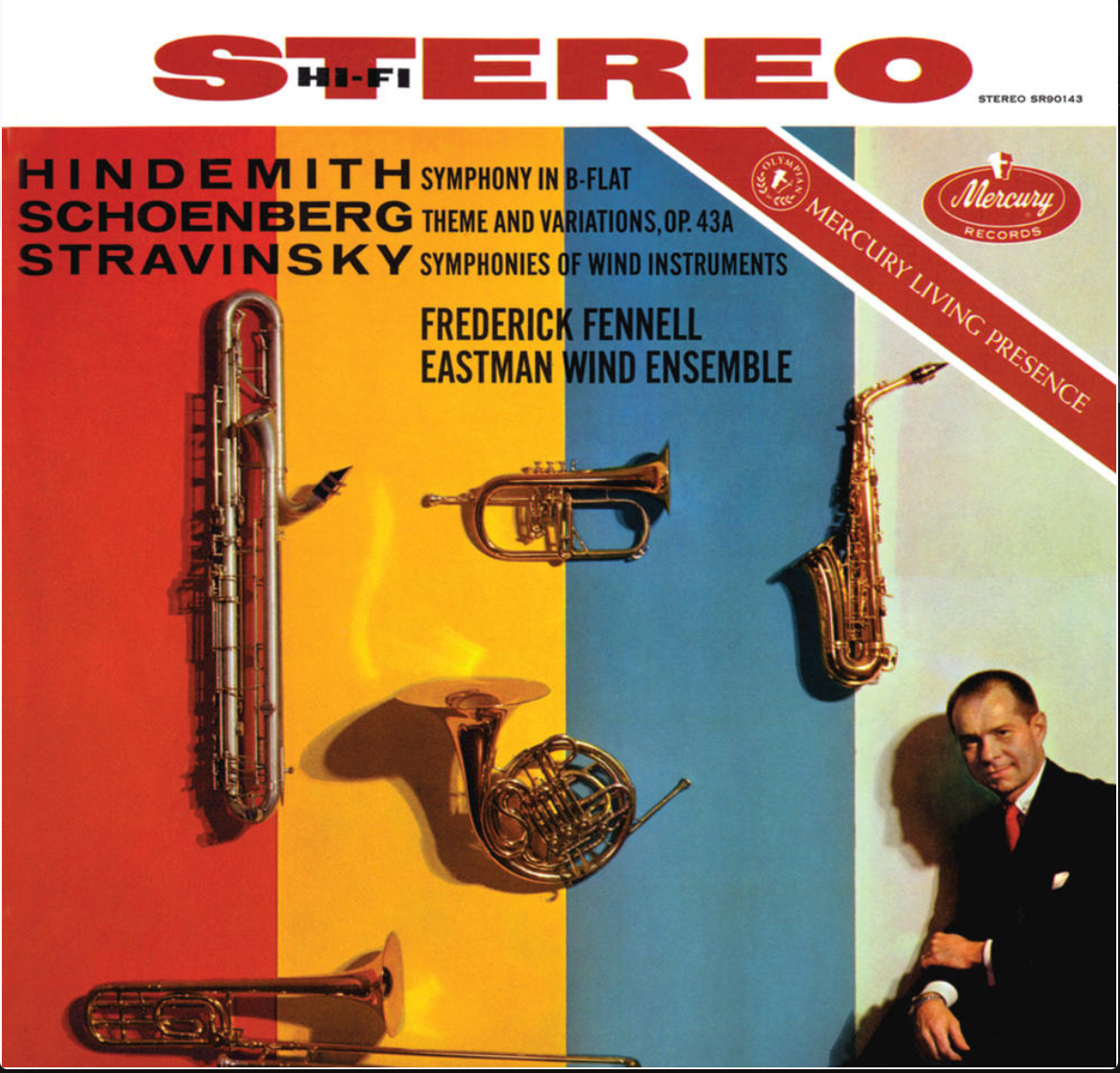Notes by Frederick Fennell
This is the premiére recording for Paul Hindemith’s Symphony in B Flat (1951) and for Arnold Schoenberg’s Variations, Opus 43a (1943), two serious scores of fairly recent vintage. By coupling these “new” works with Igor Stravinsky’s thirty-seven-year-“old” masterpiece, Symphonies of Wind Instruments (1920—revised 1947), it is possible for us to present three divergent concepts of the current wind medium in these major contributions to its ever-growing musical literature by composers of the first rank. With this continuing series of long-playing records by the Eastman Symphonic Wind Ensemble, Mercury and the Eastman School of Music seek to set forth the present state of the musical literature for the wind band and for the symphonic wind ensembie. Our previous recordings for Mercury in the field of symphonic repertory have included representative scores by American and British composers. Much of the best in the areas of field music and military marches by outstanding creators of these little masterpieces likewise has been both British and American in origin.
This far from accidental emphasis upon Anglo-American repertory has come about mostly because the music of quality which it represents has been or is becoming the basic repertory of our country’s vast wind band activity. The interest, understanding, and sympathy of the composers thus represented is only now beginning to reward those long-patient and devoted souls to whom the wind medium is a happy and exciting form of musical life. This interest, however, is by no means confined to Englishmen and Americans. We are all the more pleased, therefore, to present on this disc three provocative scores by men who descend creatively from origins other than Anglo-American.
It is too obvious, perhaps, but it is likewise undeniably true, that the present and future state of musical literature for all mediums of performance is sustained by the continuing interest of composers. The fabrication of an instrumental ensemble, however, is the end result of the combined skills and interests of instrumental designer-manufacturers and performers; but this joint industry waits upon the composer for the full realization of their work. Without the composer, all instrumental apparatus is relegated to vain wish and unfulfilled desire, conditions in which those agglomerations of wind and percussion instruments called bands have languished for over a century. In the final analysis it will be the composer who will decide the future of the wind band. This has been the history of those vast and great musical treasures which dwell in health in the mansions of the orchestra, the opera house, and the chamber music hall — treasures bountifully stored up for all to whom life without music would be toil without reward.
A medium of musical performance may vary with time. It may even perish as did the noble family of lutes, leaving a beautiful literature in their passing. When those various flat- and round-backed precursors of today’s string family gave way to Salo’s violin, it was the designers and builders working with the performers who eventually relegated their previous medieval masterpieces to the museum. But this was achieved only after the composer realized in the violins the presence of a more versatile, powerful and beautiful imitation of the human voice.
There is an appreciable comparison (provided one does not make it with the orchestra) in the development of the wind band. In this instance it may seem that the judgment of the composer, however, has been harsh and prejudiced. It may also be that, in his infinite wisdom, his rejection of it as an ensemble for his serious consideration has forced those men of honest purpose who conduct and otherwise devote themselves toward its acceptance to probe ever more deeply into themselves and the medium to discover why this should be. If this is the real truth of the matter, and if those who are associated with the wind medium might have begun to purge themselves of charlatanism and artistic iniquities —then, perhaps, the silent treatment dealt to the band by great creators in the past century has made a proper effect, But if this is true — as I firmly believe it to be — then our present gains in performance and education have been achieved at great price; that price includes no music for the wind band by such influential 20th-century instrumental composers as Richard Strauss, Debussy, Ravel, Sibelius, Bartók, and Mahler — recalling but a few that come quickly and painfully to mind.
The reasons why they wrote nothing for the massed wind ensemble (if they ever really thought of it at all) lie locked with them in the silence of peace. One can only conjecture, and it is in such considered reflection and study of the history of musical ensembles and their literature that we came to the establishment of the Eastman Wind Ensemble, to the choice of its name, and to this series of recordings of its repertory. At the outset in 1952 it was our dream and it now becomes our duty to contribute what we can to the establishment of an artistic ensemble medium that few true composers of stature and conscience can long ignore. If they in turn reject it, the fault we can honestly hope shall not have been ours.
Paul Hindemith (born 1895) wrote his Symphony in B Flat in 1950-51 at the request of Major Hugh Curry who had invited Hindemith to appear as guest conductor of the U.S. Army Band at one of its concerts in the Nation’s capital on April 5, 1951. Following his admirable life-long practise of supplying music as he sees it to every conceivable form of musical art, Hindemith furnished no mere bagatelle for the occasion. In 1952, the year of its issue by Schott (Hindemith’s publisher) it was quickly established as one of the most important scores in a season filled with significant music for the ranking musical forms by the leading men of our time. A masterpiece in contrapuntal writing and brilliant orchestration, it represents the fulfillment of long-held desires for a major symphonic piece of length, breadth, and content, the substance of which might serve as a model to those whose courage toward the wind band suffers much from the lack of example. Scoring is for a full complement of players and it was recorded by the Wind Ensemble’s 26 reeds, 17 brass, and 3 percussion.
Arnold Schoenberg (1874-1951) wrote his Variations, Opus 43a in 1943, eight years before he died in Hollywood, California. Like his colleague Paul Hindemith, he responded to a request for a serious work, but unlike Hindemith, he wrote with no particular occasion in mind, although the Goldman Band gave its première in the year of its completion. Schoenberg’s score was commissioned by his publishers, G. Schirmer, Inc., at the suggestion of his son-in-law, Felix Greissle, who was then employed by them. It was intended that this work should be playable by the school bands of the United States. The cause of “playable” music is certainly understandable, but too often its end musical results are a compromise of the composer’s psyche affording neither challenge to the performer nor satisfaction to the listener, nor granting much that is honest to the craft of composition. A long-time foe of compormise, Schoenberg produced a work in the full stride of his maturity that is neither forbidding nor effete – one that is filled with a rich harmonic fabric that often betrays intense artistic admiration and deep personal affection for his friend George Gershwin. When the Variations were judged “beyond” the grasp of that vast commercial market in the schools he reversed the time-honored procedure and transcribed them for orchestra as Opus 43b. The circle seems to be closing, however, for Opus 43a appears with increasing frequency on the programs of our outstanding university concert bands and those of the rapidly growing number of symphonic wind ensembles.
Igor Stravinsky’s (born 1882) Symphonies of Wind Instruments is one of the masterpieces of 20th-century music. Written in the recoil of his instrumental usage from the heights of Rite of Spring, its modest instrumentation of 3 flutes, 2 oboes, English horn, 3 B-flat clarinets, 2 bassoons, contra-bassoon, 4 horns, 3 trumpets, 3 trombones and tuba represents what we have chosen to call a symphonic wind ensemble. The Symphonies written in memory of Claude Debussy, were designed for performance by the wind section of any symphony orchestra. Serge Koussevitzky first performed them in this fashion at a London concert on June 10, 1921. Stravinsky describes them as “an austere ritual, which is unfolded in terms of short litanies between different groups of homogenous instruments.” These are the sounds of genius, so classically balanced that to remove one bar or to add another would seriously impair their relationship. Like Mozart’s magical Serenade No. 10 in B Flat (K. 361), from which it is “descended,” it reveals again that composers with a true preception of the wind instruments as a sonority for performance by themselves may be as rare as the true genius himself.
But in view of the three scores constituting this disc, it could be that the genius is at last beginning to behold the wind medium with a long-denied respect.
Notes about this recording
Writing in the English publication, Gramophone Record Review, the critic Malcolm Rayment described a previous Mercury Living Presence release by Frederick Fennell and the Eastman Wind Ensemble (MGS50084) in the following words: “I am not given to rash statements, but I think that this is the finest recording achievement that I have ever heard. I am glad to say that only one microphone was used, for I believe that this is the way to achieve the best results. Problems of balance should be left to the conductor and not to recording engineers. I know only too well how frustrating it is to achieve a perfect balance in the studio and have it completely falsified in the control box.”
Mercury’s basic recording philosophy is that all musical matters, such as orchestral balance, nuance and dynamics, should be left in musical hands. Therefore, for stereo sessions, Mercury’s famed single-microphone technique is adapted to the stereo medium by the use of three microphones – one for each of the three stereo channels. Pinpointing the location of each microphone is a delicate operation since correct placement generally falls within a radius of inches. Once this aural “focus” has been determined and the decibel levels have been checked, controls of balance and dynamics are left in the hands of the conductor. In this way, the full musical brillance of true stereo recording is faithfully captured on each Mercury Living Presence record.
Wilma Cozart was the recording director for this session; Harold Lawrence was the musical supervisor; C. Robert Fine was the engineer and technical supervisor; and tape-to-disc transfer was made by George Piros.



